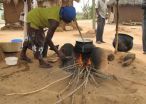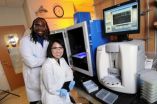(Press-News.org) Contact: David Hosansky
hosansky@ucar.edu
303-497-8611
National Center for Atmospheric Research/University Corporation for Atmospheric Research
Zhenya Gallon
zhenya@ucar.edu
303-497-8607
National Center for Atmospheric Research/University Corporation for Atmospheric Research
Christine Wiedinmyer
christin@ucar.edu
303-497-1414
National Center for Atmospheric Research
Mary Hayden
mhayden@ucar.edu
303-497-8116
National Center for Atmospheric Research
Scientists launch international study of open-fire cooking and air quality
BOULDER -- Expanding its focus on the link between the atmosphere and human health, the National Center for Atmospheric Research (NCAR) is launching a three-year, international study into the impact of open-fire cooking on regional air quality and disease.
The study will break new ground by bringing together atmospheric scientists, engineers, statisticians, and social scientists who will analyze the effects of smoke from traditional cooking methods on households, villages, and entire regions.
Researchers will combine newly developed sensors with computer and statistical models to look at what happens to human health when traditional cooking methods are used. They will also evaluate whether newer, more efficient cookstoves could reduce disease and positively affect regional air quality.
The project brings together a diverse team of pollution, climate, and health experts from NCAR, the University of Colorado Boulder, University of Ghana School of Public Health, and Ghana Health Services. Funding comes from the National Science Foundation, NCAR's sponsor.
The researchers will focus primarily on northern Ghana, where they will examine possible links between air pollutants and such diseases as meningitis. Their findings are expected to provide information to policymakers and health officials in other developing countries where open-fire cooking or inefficient stoves are common.
"Often when you visit remote villages in Ghana, they're shrouded in haze for many miles from all the fires used for cooking," says NCAR scientist Christine Wiedinmyer, an atmospheric chemist overseeing the project. "Given that an estimated three billion people worldwide are cooking over fire and smoke, we need to better understand how these pollutants are affecting public health as well as regional air quality and even the climate."
Wiedinmyer and her colleagues will use a novel combination of local and regional air quality measurements—including specialized smartphone applications that are more mobile than traditional air quality sensors—and cutting-edge computer models of weather, air quality, and climate. The researchers and student assistants will also survey villagers to get their views on possible connections between open-fire cooking and disease as well as their interest in adopting different cooking methods.
Cooking fires in developing countries are a leading source of carbon monoxide, particulates, and smog. These can cause a variety of symptoms, ranging from relatively mild ailments, such as headaches and nausea, to potentially life-threatening conditions, including cardiovascular and respiratory diseases.
The fires also emit carbon dioxide and other heat-trapping gases that, when mixed into the global atmosphere, can affect weather patterns and warm the climate. As regional temperatures warm, that in turn can act to increase the level of air pollution, thereby potentially leading to greater health risks.
The project builds on other NCAR projects studying links between the atmosphere and human health. These include the development of specialized forecasts of weather conditions associated with the beginning and end of outbreaks of meningitis in Africa.
"We're excited about the opportunity to continue working with our collaborators in Ghana and to help alleviate a major health problem across the Sahel of Africa," says NCAR's Mary Hayden, a medical anthropologist. "Bringing together an international transdisciplinary team of social scientists with climatologists, atmospheric chemists, and engineers to tackle the problem is the first step in addressing these complex human-environmental problems."
INFORMATION:
The University Corporation for Atmospheric Research manages the National Center for Atmospheric Research under sponsorship by the National Science Foundation. Any opinions, findings and conclusions, or recommendations expressed in this publication are those of the author(s) and do not necessarily reflect the views of the National Science Foundation.
On the Web
News releases, visuals, and more:
www.ucar.edu/atmosnews
Scientists launch international study of open-fire cooking and air quality
2012-11-01
ELSE PRESS RELEASES FROM THIS DATE:
Genetic test results for Lynch syndrome improved with new computer program
2012-11-01
SALT LAKE CITY—Many patients who have genetic testing for Lynch syndrome, a hereditary predisposition to colon cancer, receive the inconclusive result "variants of uncertain clinical significance." This can be a problem, as people with Lynch syndrome have a much higher probability to develop colon cancer, and often develop colon cancer at an earlier age than is common among the general population; consequently, they need to begin screening at a much younger age.
Now, between two-thirds and three-fourths of these genetic variants can be classified into categories that ...
Brain may 'see' more than the eyes, study indicates
2012-11-01
Vision may be less important to "seeing" than is the brain's ability to process points of light into complex images, according to a new study of the fruit fly visual system currently published in the online journal Nature Communications.
University of Virginia researchers have found that the very simple eyes of fruit fly larvae, with only 24 total photoreceptors (the human eye contains more than 125 million), provide just enough light or visual input to allow the animal's relatively large brain to assemble that input into images.
"It blows open how we think about vision," ...
IU researchers report first effective treatment of tumors arising from common genetic disease NF1
2012-11-01
Physician-researchers at Indiana University School of Medicine have reported the first effective therapy for a class of previously untreatable and potentially life-threatening tumors often found in children.
Announcing their findings in the online first edition of Lancet Oncology, the researchers said the drug imatinib mesylate, marketed as Gleevec as a treatment for chronic myeloid leukemia, provided relief to a significant number of patients with plexiform neurofibromas, tumors caused by neurofibromatosis type 1, or NF1.
"Although this was a small study, the results ...
Super-rare, super-luminous supernovae are likely explosion of universe's earliest stars
2012-11-01
The most-distant, super-luminous supernovae found to date have been observed by an international team, including Raymond Carlberg of the University of Toronto's Department of Astronomy & Astrophysics. The stellar explosions would have occurred at a time when the universe was much younger and probably soon after the Big Bang.
"The objects are both unusually bright and unusually slow to fade. These are properties that are consistent with what is known as pair-instability supernova, a rare mechanism for explosion which is expected to happen for high-mass stars with almost ...
Stem cells could heal equine tendon injuries
2012-11-01
Tendon injuries affect athletic horses at all levels. Researchers from the University of Connecticut are studying the use of stem cells in treating equine tendon injuries. Their findings were published Oct. 16 in the Journal of Animal Science Papers in Press.
Tendon injuries in horses tend to worsen over time as damage to the tendon creates lesions. Currently, horse owners treat tendon injuries by resting the horse and then carefully exercising the horse to control the growth of scar tissue in the tendon. Unfortunately, this treatment does not always work.
"These injuries ...
LSUHSC research identifies new therapeutic target for Alzheimer's disease
2012-11-01
New Orleans, LA – Research led by Chu Chen, PhD, Associate Professor of Neuroscience at LSU Health Sciences Center New Orleans, has identified an enzyme called Monoacylglycerol lipase (MAGL) as a new therapeutic target to treat or prevent Alzheimer's disease. The study was published online November 1, 2012 in the Online Now section of the journal Cell Reports.
The research team found that inactivation of MAGL, best known for its role in degrading a cannabinoid produced in the brain, reduced the production and accumulation of beta amyloid plaques, a pathological hallmark ...
Rethinking reading
2012-11-01
Many educators have long believed that when words differ on only one sound, early readers can learn the rules of phonics by focusing on what is different between the words. This is thought to be a critical gateway to reading words and sentences.
But scientists at the University of Iowa are turning that thinking on its head. A recent study published in "Developmental Psychology" shows certain kinds of variation in words may help early readers learn better. When children see the same phonics regularities, embedded in words with more variation, they may learn these crucial ...
Laser-light testing of breast tumor fiber patterns helps show whose cancer is spreading
2012-11-01
Using advanced microscopes equipped with tissue-penetrating laser light, cancer imaging experts at Johns Hopkins have developed a promising, new way to accurately analyze the distinctive patterns of ultra-thin collagen fibers in breast tumor tissue samples and to help tell if the cancer has spread.
The Johns Hopkins researchers say their crisscrossing optical images, made by shining a laser back and forth across a biopsied tissue sample a few millionths of a meter thick, can potentially be used with other tests to more accurately determine the need for lymph node biopsy ...
George Mason University researchers target breast cancer in 3 trials
2012-11-01
Fairfax, Va. -- A malarial drug is showing promise in stopping breast cancer before it starts, Mason researchers are discovering during a clinical trial.
"The bold long-term goal is a short-term oral treatment that prevents breast cancer by killing the precursor cells that initiate breast cancer," says Lance Liotta, co-director of Mason's Center for Applied Proteomics and Molecular Medicine (CAPMM). "And it's looking hopeful."
The PINC trial (Preventing Invasive Neoplasia with Chloroquine) targets ductal carcinoma in situ, or DCIS, the most common type of pre-invasive ...
Researchers use blood testing to predict level of enzymes that facilitate disease progression
2012-11-01
Predicting how atherosclerosis, osteoporosis or cancer will progress or respond to drugs in individual patients is difficult. In a new study, researchers took another step toward that goal by developing a technique able to predict from a blood sample the amount of cathepsins—protein-degrading enzymes known to accelerate these diseases—a specific person would produce.
This patient-specific information may be helpful in developing personalized approaches to treat these tissue-destructive diseases.
"We measured significant variability in the amount of cathepsins produced ...



